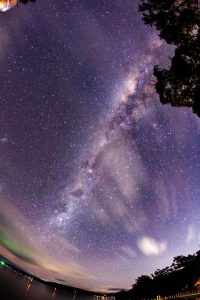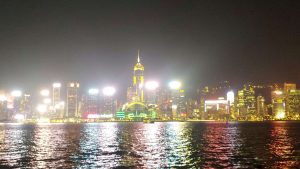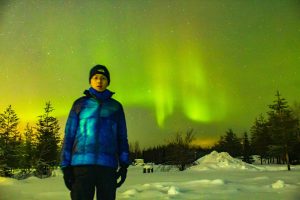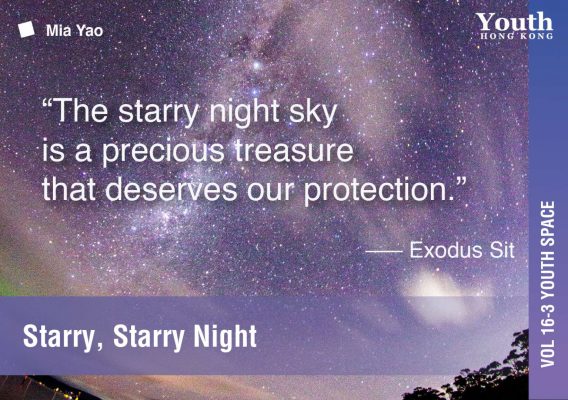//16.3 Youth space: Nature
Starry, Starry Night
by Mia Yao
Hong Kong-based educator, Exodus Sit, shares his passion for astronomy and dedication to protecting the night sky.
Clean water, healthy food, fresh air and sunshine, are essential things we often take for granted. How about the sky? Do we ever consider that one day, even the dark blue night sky might become a scarce commodity?
Hong Kong, a bustling metropolis illuminated by billboards and advertising screens, is facing a light pollution problem of unprecedented levels. But we’re not alone in this. A study shows that over 80% of the world’s population lives under light-polluted skies.

Hong Kong-based educator, Exodus Sit, shares his passion for astronomy and dedication to protecting the night sky.
Exodus Sit, 26, an amateur astrophotographer and astronomy educator, has been to more than 50 countries and regions on stargazing trips. He is saddened by the fact that Hong Kong residents seldom have occasion to enjoy and appreciate the beauty of a twinkling night sky, not only because of the light pollution, but also because they simply do not make the time to look up.
For Exodus, the hours spent gazing into the night sky give him inner peace and the opportunity to contemplate. “Leaving behind all my worries, I feel relaxed and lose track of time. I wonder how I can share this beautiful night sky with others, especially young people.”
Encouraged by his family, and fuelled by curiosity about astronomy since primary school, Exodus joined the astronomy club in Secondary 3 when he became more intrigued by the mystery of the stars.
Disappearing Stars
What he has learnt over time still astounds him. There are approximately 200 billion trillion stars in the galaxy, which have been there before life began on earth. Yet in Hong Kong, these luminous objects are losing their visibility.
Measured according to the dark site standard of the International Astronomical Union (IAU), Hong Kong’s night sky is 82 times brighter than the dark site standard, with the most severe case recorded in Tsim Sha Tsui being 1,200 times brighter than what it should be. Because of all this excessive artificial lighting, stars have become obscured in urban areas, and stargazing enthusiasts are forced to seek out starry nights elsewhere.

Hong Kong’s night sky is 82 times brighter than the dark site standard, with the most severe case recorded in Tsim Sha Tsui.
“Sai Kung used to have more stars visible than today. However, lights from the city and fishing boats are making it challenging to see stars even in remote suburban areas,” Exodus said.
To create a darker and less-disturbing environment, the Hong Kong government introduced the voluntary Charter on External Lighting in 2016, to reduce light nuisance by encouraging operators to switch off external lighting installations from midnight to the next morning. Enhancements to the Charter took effect from 2023 and a new tier with more stringent requirements is introduced. However, the voluntary nature of this measure has its limitations. Dealing with light pollution has proven to be more complicated than just asking people to switch off lights.
The challenges in regulating outdoor lighting stem from the city’s dense urban environment with mixed commercial-residential areas, the difficulty in pinpointing specific sources of light nuisance, and the absence of universally agreed-upon standards for measuring light pollution. All these factors are compounded by the need to balance regulation with economic and safety considerations.
Astronomy for Inclusivity
Having been engaged in workshops with government officials and writing columns, Exodus wishes to collaborate with organisations and raise awareness about night sky protection. He believes that individuals can also play an indispensable part. “It can start from using equipment like light shoeboxes and light controllers in outdoor spaces to prevent unwanted light from intruding into neighbouring spaces. Everyone can take action to reduce unnecessary lighting.”
With a diverse background in astrophysics, mathematics and music, Exodus is passionate about sharing his knowledge through education. His dream is to add astronomy and night sky protection into the school curriculum. “Astronomy is a transdisciplinary subject which involves physics, mathematics, and sometimes even music. What these subjects have in common is that they are abstract. I want to make the abstract concepts in these subjects more approachable and fun to learn for everyone.”
In fact, in 2019, he successfully sent a Cantonese song into the stratosphere 30 km above the sky. In 2021, at the height of the pandemic, he discovered an Apollo asteroid and was officially recognised by the IAU Minor Planet Center.

Hong Kong-based educator, Exodus Sit, shares his passion for astronomy and dedication to protecting the night sky.
In Exodus’s opinion, astronomy education is about sharing knowledge and happiness with everyone, regardless of nationality, culture, language and financial status, because we are all looking up into the same sky. As a result, he hopes popularising astronomy can promote inclusiveness and sustainability within different communities.
Referencing the importance of stars and constellations in Greek mythology, Exodus sees night sky preservation as a cultural inheritance, necessary to pass on. “The starry night sky is a precious treasure that deserves our protection, ensuring it can be cherished by future generations.” ■
Some recommended stargazing locations in Hong Kong where you can enjoy clear views of the night sky:
Astropark: Located in Sai Kung, this park was set up by the Hong Kong Space Museum and offers facilities such as reclining benches and free binoculars for public use.
Sai Wan Stargazing Site: Situated along the Maclehose Trail, this site provides a serene environment away from city lights, making it ideal for observing stars.
Cape D’Aguilar: This scenic spot south of Shek O offers panoramic views of the sky and sea, making it a great location for stargazing, especially during clear nights.
Sunset Peak (Tai Tung Shan): Located on Lantau Island, this peak requires a hike but rewards visitors with minimal light pollution and expansive views of the night sky.
Kowloon Peak Viewing Point: Known for its stunning vistas, this viewing point is also suitable for stargazing.
Exodus Sit is an amateur astrophotographer and astronomy educator. He has travelled to over 50 countries and regions for stargazing trips and has participated in the Federation’s STEAM education programme.
References:
- The new world atlas of artificial night sky brightness
- CNN: Hong Kong’s light pollution ‘worst in the world’, March 2013
- The Hong Kong Institution of Engineers, Light pollution: the Hong Kong situation and overseas regulations
- Legislative Council: Regulation of nuisance caused by external lighting
- HKSAR Press Release: LCQ8: Reducing light pollution
- Opinion Survey Study on External Lighting in Hong Kong Final Report




